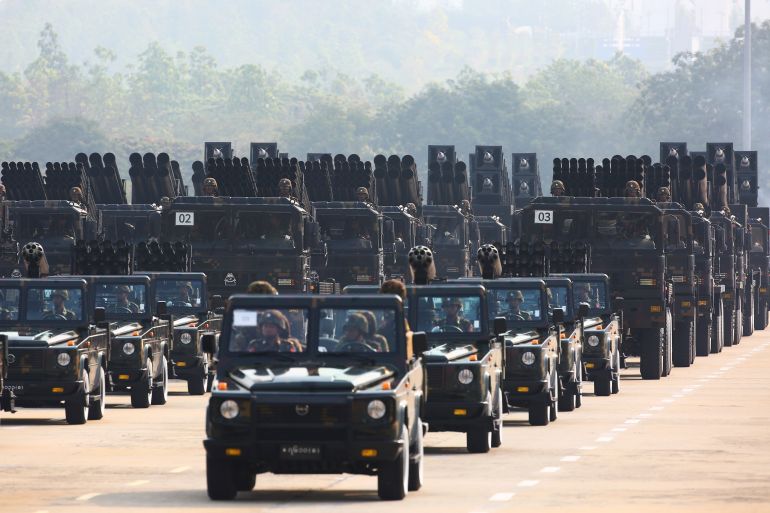Myanmar military has imported weaponry worth $1bn since coup
UN expert says Russia, China and companies in Singapore top list of those sending weapons to military accused of abuses.

Myanmar’s military has imported arms worth at least $1bn since seizing power in February 2021, despite “overwhelming evidence of its responsibility for atrocity crimes”, a United Nations expert has said.
Most of the weapons came from Russia, China and companies in Singapore, Tom Andrews, the UN Special Rapporteur on Human Rights in Myanmar said in a report [PDF] released on Wednesday in New York.
Keep reading
list of 4 itemsMyanmar military used vacuum bomb on opponents: HRW
Flooding, communications blackout as Cyclone Mocha hits Myanmar
Under pressure, ASEAN says ‘deeply concerned’ at Myanmar violence
The exports cover weapons, dual-use technology and materials used to manufacture weapons exported from the day of the coup on February 1, 2021, to December 2022.
“These weapons, and the materials to manufacture more of them, have continued to flow uninterrupted to the Myanmar military despite overwhelming evidence of its responsibility for atrocity crimes,” said the report. It identified more than 12,500 unique purchases or recorded shipments directly to the Myanmar military or known Myanmar arms dealers working on the military’s behalf.
“The diversity and volume of goods provided to the Myanmar military since the coup is staggering,” it added, saying the military had taken delivery of weapons and equipment from fighter jets to drones, communications equipment and components for navy ships.
Myanmar was plunged into crisis by the coup, which triggered mass protests. A deadly crackdown ignited armed resistance, with ethnic armed groups that have long been fighting the military joining forces with so-called People’s Defence Forces (PDFs) to fight against the generals.
The PDFs are aligned with the National Unity Government (NUG) established by legislators removed in the coup and others opposed to military rule.
The UN and rights groups have accused the military of human rights abuses in its attempts to suppress opposition, saying some incidents may amount to war crimes and crimes against humanity.
In his report to the UN’s Human Rights Council in Geneva, Andrews pointed to last month’s attack on Pazigyi village in the central Sagaing region, where reports indicate near-daily confrontations between resistance forces and soldiers.
As some 300 villagers, including children, gathered to mark the opening of a new NUG office, a Russian-made Yak-130 fighter jet dropped two 250kg (550 pounds) bombs on the crowd.
“The ordinance detonated with deadly impact – ripping the bodies of men, women, and children open, turning their skin to ash, and inflicting critical shrapnel wounds,” the report said.
Amid the carnage, the attack continued as two Mi-35 attack helicopters fired on the survivors and those trying to help the wounded.
At least 160 people were killed and the remains of only 59 people were identifiable, the report noted.
“The attack is yet another example of the Myanmar junta’s probable crimes against humanity and war crimes against the people of Myanmar,” it said.
No doubt about buyer
According to the report, Russian entities were the source of $406m of the arms and related-equipment, China entities $254m and Singapore-operating entities $254m.
Armaments were also sent from entities in India ($51m) and Thailand ($28m).
State-owned entities in Russia, China and India were among those Andrews identified as exporters.
“Over $947 million of arms-related trade identified went directly to entities controlled by the Myanmar military—e.g., the Directorate of Procurement, Directorate of Defense Industries, or specific branches of the military like the Myanmar Air Force or Tatmadaw Basic Training School,” the report said.
“This means that the military itself was listed as recipient on trade-related documents, eliminating any doubt of who the end recipient would be.”
Andrews said he had shared his findings with the relevant governments.
In their response, Russia and China accused the rapporteur of going beyond his mandate and “vilifying legitimate arms trade”.
India, meanwhile, said the arms contracts involving state-owned companies had been signed by a previous government.
Andrews noted that he had found no information indicating that entities owned or controlled by the governments of Singapore or Thailand, or the governments themselves, had approved or transferred the arms to the Myanmar military, and that it seemed arms dealers were using the territories to carry out their business “specifically the banking and shipping sectors”.
As a result of the report, the Singapore government indicated it was reviewing the effectiveness of its export controls, Andrews said.